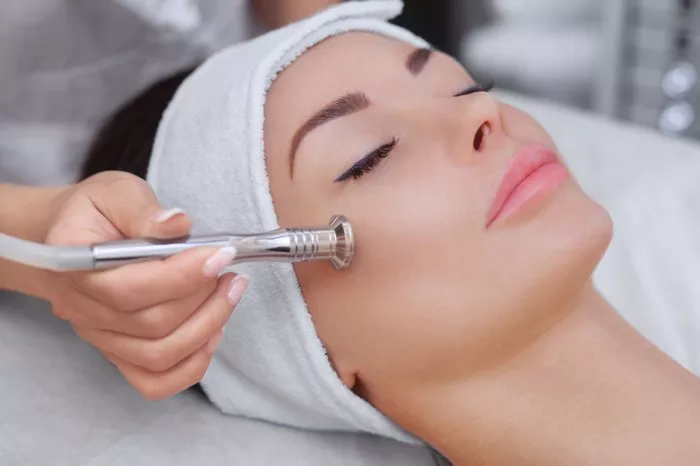Acne is a common skin condition that affects individuals of all ages, causing pimples, blackheads, and blemishes. Many people seek effective treatments to improve the appearance of acne-prone skin and minimize the occurrence of breakouts. Microdermabrasion is a non-invasive cosmetic procedure that has gained popularity for its potential benefits in addressing acne. In this article, we will explore how microdermabrasion can benefit individuals with acne-prone skin and improve the overall complexion.
Understanding Microdermabrasion
Microdermabrasion is a skin rejuvenation technique that exfoliates the outermost layer of the skin to reveal a smoother, more vibrant complexion. It involves the use of a handheld device that delivers a controlled stream of fine crystals or a diamond-tipped wand across the skin’s surface. This exfoliation process removes dead skin cells, unclogs pores, and stimulates collagen production.
Benefits of Microdermabrasion for Acne
Microdermabrasion can offer several benefits for individuals with acne-prone skin. While it may not completely eliminate acne, it can help improve the appearance of the skin and reduce the frequency of breakouts. Here are some ways in which microdermabrasion can benefit individuals with acne:
1. Exfoliation and Unclogging Pores
Acne-prone skin often has a build-up of dead skin cells, excess oil, and debris that can clog the pores and contribute to the development of acne. Microdermabrasion effectively exfoliates the skin, removing the outermost layer of dead skin cells and unclogging the pores. This process can help reduce the occurrence of blackheads, whiteheads, and pimples.
2. Enhanced Absorption of Skincare Products
After microdermabrasion, the skin’s surface becomes smoother and more receptive to skincare products. This enhanced absorption allows acne-fighting ingredients, such as topical medications or serums, to penetrate more deeply into the skin. As a result, the active ingredients can work more effectively to target acne-causing bacteria and reduce inflammation.
3. Stimulation of Collagen Production
Microdermabrasion stimulates collagen production in the deeper layers of the skin. Collagen is a structural protein that helps maintain the skin’s elasticity and firmness. By stimulating collagen production, microdermabrasion can improve the overall texture and tone of the skin, making it appear smoother and reducing the appearance of acne scars and blemishes.
4. Reduction in Post-Inflammatory Hyperpigmentation
Acne breakouts can often lead to post-inflammatory hyperpigmentation, which is characterized by dark spots or discoloration in the affected areas. Microdermabrasion can help fade these post-inflammatory hyperpigmentation marks by promoting the turnover of skin cells and encouraging the growth of new, healthier skin.
5. Minimal Downtime and Quick Recovery
One of the advantages of microdermabrasion for acne is that it is a non-invasive procedure with minimal downtime. Unlike more aggressive treatments, microdermabrasion does not require anesthesia or extensive recovery periods. After the treatment, individuals can resume their normal activities immediately, with only mild redness or sensitivity that typically subsides within a day or two.
6. Improves Skin Texture and Radiance
Acne-prone skin can often appear dull, rough, and uneven. Microdermabrasion works to smooth the skin’s surface, resulting in a more refined texture and a radiant glow. By removing the outer layer of dead skin cells and stimulating collagen production, microdermabrasion can help individuals achieve a healthier and more youthful-looking complexion.
7. Complementary Treatment with Other Therapies
Microdermabrasion can be used in combination with other acne treatments to enhance their efficacy. For example, it can be performed before applying topical acne medications or in conjunction with chemical peels or light-based therapies. This combination approach can provide a comprehensive treatment plan for acne-prone skin and yield better results.
Important Considerations
While microdermabrasion can offer significant benefits for individuals with acne, it is essential to consider a few important points:
1. Severity of Acne
Microdermabrasion is generally suitable for individuals with mild to moderate acne. If you have severe or cystic acne, it is advisable to consult with a dermatologist or skincare professional who can evaluate your condition and recommend appropriate treatment options.
2. Individualized Treatment Plans
Each individual’s skin is unique, and the treatment plan should be tailored to their specific needs and concerns. Consulting with a qualified aesthetic professional is crucial to assess your skin type, acne severity, and desired outcomes. They can design a personalized microdermabrasion treatment plan that addresses your specific concerns and maximizes the benefits.
3. Maintenance and Consistency
To maintain the results of microdermabrasion for acne, regular maintenance sessions may be necessary. The frequency of these sessions will depend on your skin’s response and the recommendations of your skincare professional. Consistency in following a skincare routine, using appropriate products, and adopting healthy lifestyle habits is also important in managing acne-prone skin.
Conclusion
Microdermabrasion can be a valuable addition to the skincare regimen for individuals with acne-prone skin. By exfoliating the skin, unclogging pores, stimulating collagen production, and improving overall skin texture, microdermabrasion can help reduce the occurrence of breakouts and enhance the appearance of acne-prone skin. It is important to consult with a qualified aesthetic professional to develop a personalized treatment plan that addresses your specific concerns and ensures the best possible results. With proper care and consistent treatment, microdermabrasion can contribute to a clearer, smoother, and more radiant complexion for individuals with acne.


